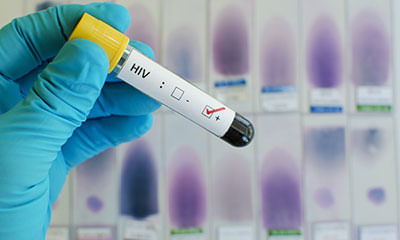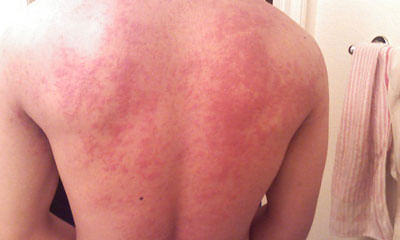How Long Does A Viral Rash Last
I am 36 years of age single. From last two days I was getting a skin infection called herpes zoster. I have consult a sk ...
Ask Free Question
The rash associated with herpes zoster most often occurs on the trunk and buttocks. It may also appear on the arms, legs or face. But we have to look into the details of the problem. Let's have a detailed discussion to Ensure proper treatment
Hi, I don't have any rashes or something like that but whenever my body heats up a little bit a current started to flow ...
Ask Free Question
Infections that cause rashes may be fungal, bacterial, parasitic, or viral. i need detailed case history to find out cause and treat accordingly. homoeopathic treatment cures rashes, there are many homoeopathic medicines like arsenic alb, psor , apis mel , bella , urtica u, sulphur, tuberculinum, mezer, petroleum, calad, hepar s , kali sulph etc.. you can consult me online for treatment and guidance..
Dear sir, I think mujhe koi viral infection hua hai, but wo samz nai aaraha. Mai 2001se es bimari se paresha hu shuru me ...
Ask Free Question
Dear first thing if its since 2001 as you mentioned above why you took so long to notify it and first get cbc and viral markers test done and revert me reports, will guide accordingly further.
What home remedies is the best for viral fever? And I want to know the medicines as well which will be good. Please sirs ...
Ask Free Question
Viral fever is any fever that happens as a result of a viral infection. Unlike bacterial infections, viral illnesses don’t respond to antibiotics. Instead, most simply have to run their course. This can take anywhere from a couple of days to a week or longer, depending on the type of infection. A high fever can be more dangerous for a young child than an adult. Along with high temperature, you have other symptoms, such as a rash, cough, or diarrhoea, you should consult a doctor. You can try the following tips to help you with your viral fever, 1) drink fluids - try to drink as much as you can when you have a viral fever to replenish lost fluids. Juice, diluted sports drinks, broths, soups, decaffeinated tea. 2) get plenty of rest - try to avoid as much physical activity as possible. Aim for eight to nine hours or more of sleep per night. During the day, take it easy. 3) you can take an over-the-counter medication - acetaminophen, ibuprofen, naproxen 4) stay cool - you can help cool down your body by surrounding it with cooler temperatures. Make sure you don’t overdo it. If you start to shiver, stop immediately. Shivering can cause your fever to rise. Give yourself a sponge bath with lukewarm water. Drink plenty of cool or room-temperature water. Use a fan to keep air circulating. Finally, a viral fever is usually nothing to worry about. In both children and adults, most viruses resolve on their own and are part of the healing process. But if you notice unusual symptoms or a fever doesn’t go away after a day or so, it’s best to call your doctor.
I am 20 years old and suffering from sore throat, mild fever and red rash on body (chest and back) some days not everyda ...
Ask Free Question
1. Do saline gargles daily. 2. Whenever possible do steam inhalation also. 3. Cover your nose and mouth with hanky for at least 30 sec when you go in dusty areas also when you go in and out of ac. As our nose is the most sensitive part of our body, when there is temperature difference between two rooms or inside n outside, then if we not protect our nose, it gets affected. 4. Drink hot liquids --hot liquids relieve nasal congestion, prevent dehydration, and soothe the uncomfortably inflamed membranes that line your nose and throat. 5. Sleep with an extra pillow under your head-- elevating your head will help relieve congested nasal passages. If the angle is too awkward, try placing the pillows between the mattress and the box springs to create a more gradual slope. 6. Treat that stuffy nose with warm salt water-- salt-water rinsing helps break nasal congestion, while also removing virus particles and bacteria from your nose. 7. Blow your nose often (and the right way)-- it's important to blow your nose regularly when you have a cold rather than sniffling mucus back into your head. But when you blow hard, pressure can carry germ-carrying phlegm back into your ear passages, causing earache. The best way to blow your nose: press a finger over one nostril while you blow gently to clear the other. Homeopathic treatment has very encouraging results and gives relief in long term ask for consultation with detailed information so that I can help you better.
If someone has to go down with HIV illness,(last exposure 2 years back) would that person be having only fever, mild cou ...
Ask Free Question
Such syptoms can come in so. Many illnesses, not necessarily only in HIV. Why are you taking drip? If you do not have vomiting and diarrhoea, you do not need drip. Before you do any more tests and take any treatment, it is better that you take a private consult with audio video chat and then I can guide you properly and explain you what is to be done.
My blood components count are goes down Total WBC-2900, RBC-4.2, Hemoglobin-13.5 and platelet-90000 cells My body weight ...
Ask Free Question
how long u have been suffering from this complaint? Causes of thrombocytopenia can be classified in three groups: Diminished production (caused by viral infections, vitamin deficiencies, aplastic anemia, drug induced) Increased destruction (caused by drugs, heparin [HIT], idiopathic, pregnancy, immune system) Leukemia Some types of anemia Viral infections, such as hepatitis C or HIV Chemotherapy drugs Heavy alcohol consumption Thrombocytopenia signs and symptoms may include: Easy or excessive bruising (purpura) Superficial bleeding into the skin that appears as a rash of pinpoint-sized reddish-purple spots (petechiae), usually on the lower legs Prolonged bleeding from cuts Bleeding from your gums or nose Blood in urine or stools Unusually heavy menstrual flows Fatigue Enlarged spleen Jaundice foods for thromboctopenia: Lean meats such as fish, chicken and turkey are rich in protein, zinc and Vitamin B12, all of which help increase the blood platelet count. Beans contain Vitamin B9 or folate which greatly helps boost the blood platelet count. Some other foods rich in B9 are spinach, asparagus, and oranges
Is there is any precautionary vaccination of swine flu, their effectiveness and how I can get it. ...
Ask Free Question
H1N1 influenza is sometimes called "swine flu" because it is usually found in pigs. You cannot become infected with H1N1 influenza from eating pork products. The injectable form of H1N1 influenza virus vaccine is a "killed virus" vaccine and will not cause you to become ill with the flu virus that it contains. View Slideshows Natural Cold & Flu Remedies Slideshow Anatomy of a Sore Throat Slideshow Flu Slideshow: 10 Foods to Eat When You Have the Flu Related Diseases Images & Quizzes Index Natural Cold & Flu Remedies Slideshow Anatomy of a Sore Throat Slideshow Flu Slideshow: 10 Foods to Eat When You Have the Flu Patient Comments: Swine Flu - Concerns and Risks Patient Comments: Swine Flu - Symptoms and Signs Patient Comments: Swine Flu - Treatment Swine flu (H1N1 and H3N2v influenza virus) facts What is the swine flu? How is swine flu transmitted? Is swine flu contagious? What is the incubation period for swine flu? What is the contagious period for swine flu? How long does the swine flu last? What causes swine flu? Why is swine flu now infecting humans? What are swine flu symptoms and signs? What tests do health care professionals use to diagnose swine flu? What types of health care professionals treat swine flu? What is the treatment for swine flu? What is the history of swine flu in humans? What are the risk factors for swine flu? Is it possible to prevent swine flu with a vaccine? Is it possible to prevent swine flu if the swine flu vaccine (or other flu strain vaccines) is not readily available? Are there home remedies for swine flu? Was swine flu (H1N1) a cause of an epidemic or pandemic in the 2009-2010 flu season? What is the prognosis (outlook) and complications for patients who get swine flu? Where can I find more information about swine flu (H1N1 and H3N2v)? Swine flu (H1N1 and H3N2v influenza virus) facts Swine flu is a respiratory disease caused by influenza viruses that infect the respiratory tract of pigs and result in a barking cough, decreased appetite, nasal secretions, and listless behavior; the virus can be transmitted to humans. Swine flu viruses may mutate (change) so that they are easily transmissible among humans. The April 2009 swine flu outbreak (pandemic) was due to infection with the H1N1 virus and was first observed in Mexico. Symptoms of swine flu in humans are similar to most influenza infections: fever (100 F or greater), cough, nasal secretions, fatigue, and headache. The incubation period for the disease is about one to four days. Swine flu is contagious about one day before symptoms develop to about five to seven days after symptoms develop; some patients may be contagious for a longer time span. The disease lasts about three to seven days with more serious infections lasting about nine to 10 days. Vaccination is the best way to prevent or reduce the chances of becoming infected with influenza viruses. Primary-care specialists, pediatricians, and emergency-medicine doctors usually treat the disease, but other specialists may be consulted if the flu is severe and/or complicated. Two antiviral agents, zanamivir (Relenza) and oseltamivir (Tamiflu), have been reported to help prevent or reduce the effects of swine flu if taken within 48 hours of the onset of symptoms. Some researchers disagree and suggest the antiviral agents have no effect. There are various methods listed in this article to help individuals from getting the flu. Home remedies are available, but patients should check with their doctors before use; over-the-counter medications may help reduce symptoms. The most serious complication of the flu is pneumonia. What is the swine flu? Swine flu (swine influenza) is a respiratory disease caused by viruses (influenza viruses) that infect the respiratory tract of pigs, resulting in nasal secretions, a barking cough, decreased appetite, and listless behavior. Swine flu produces most of the same symptoms in pigs as human flu produces in people. Swine flu can last about one to two weeks in pigs that survive. Swine influenza virus was first isolated from pigs in 1930 in the U.S. And has been recognized by pork producers and veterinarians to cause infections in pigs worldwide. In a number of instances, people have developed the swine flu infection when they are closely associated with pigs (for example, farmers, pork processors), and likewise, pig populations have occasionally been infected with the human flu infection. In most instances, the cross-species infections (swine virus to man; human flu virus to pigs) have remained in local areas and have not caused national or worldwide infections in either pigs or humans. Unfortunately, this cross-species situation with influenza viruses has had the potential to change. Investigators decided the 2009 so-called "swine flu" strain, first seen in Mexico, should be termed novel H1N1 flu since it was mainly found infecting people and exhibits two main surface antigens, H1 (hemagglutinin type 1) and N1 (neuraminidase type 1). The eight RNA strands from novel H1N1 flu have one strand derived from human flu strains, two from avian (bird) strains, and five from swine strains. How is swine flu transmitted? Is swine flu contagious? Swine influenza is transmitted from person to person by inhalation or ingestion of droplets containing virus from people sneezing or coughing; it is not transmitted by eating cooked pork products. The newest swine flu virus that has caused swine flu is influenza A H3N2v (commonly termed H3N2v) that began as an outbreak in 2011. The "v" in the name means the virus is a variant that normally infects only pigs but has begun to infect humans. There have been small outbreaks of H1N1 influenza since the pandemic; a recent one is in India where at least three people have died. Quick Guide Common Respiratory Illnesses Common Respiratory Illnesses What to Do if You Think You Have H1N1 Swine Flu Virus If you've got fever, cough, or one of the other symptoms of the flu, you may be wondering if you have contracted the H1N1 swine flu virus. The reality is that it isn't possible to know unless specialized testing is ordered, and for uncomplicated cases of the flu in non-hospitalized patients, routine testing for the H1N1 virus is not being carried out. Learn when to seek medical care for H1N1 swine flu symptoms » What is the incubation period for swine flu? The incubation period for swine flu is about one to four days, with the average being two days; in some people, the incubation period may be as long as about seven days in adults and children. What is the contagious period for swine flu? The contagious period for swine influenza in adults usually begins one day before symptoms develop in an adult and it lasts about five to seven days after the person becomes sick. However, people with weakened immune systems and children may be contagious for a longer period of time (for example, about 10 to 14 days). How long does the swine flu last? In uncomplicated infections, swine flu typically begins to resolve after three to seven days, but the malaise and cough can persist two weeks or more in some patients. Severe swine flu may require hospitalization that increases the length of time of infection to about nine to 10 days. What causes swine flu? The cause of the 2009 swine flu was an influenza A virus type designated as H1N1. In 2011, a new swine flu virus was detected. The new strain was named influenza A (H3N2) v. Only a few people (mainly children) were first infected, but officials from the U.S. Centers for Disease Control and Prevention (CDC) reported increased numbers of people infected in the 2012-2013 flu season. Currently, there are not large numbers of people infected with H3N2v. Unfortunately, another virus termed H3N2 (note no "v" in its name) has been detected and caused flu, but this strain is different from H3N2v. In general, all of the influenza A viruses have a structure similar to the H1N1 virus; each type has a somewhat different H and/or N structure. Why is swine flu now infecting humans? Many researchers now consider that two main series of events can lead to swine flu (and also avian or bird flu) becoming a major cause for influenza illness in humans. First, the influenza viruses (types A, B, C) are enveloped RNA viruses with a segmented genome; this means the viral RNA genetic code is not a single strand of RNA but exists as eight different RNA segments in the influenza viruses. A human (or bird) influenza virus can infect a pig respiratory cell at the same time as a swine influenza virus; some of the replicating RNA strands from the human virus can get mistakenly enclosed inside the enveloped swine influenza virus. For example, one cell could contain eight swine flu and eight human flu RNA segments. The total number of RNA types in one cell would be 16; four swine and four human flu RNA segments could be incorporated into one particle, making a viable eight RNA-segmented flu virus from the 16 available segment types. Various combinations of RNA segments can result in a new subtype of virus (this process is known as antigenic shift) that may have the ability to preferentially infect humans but still show characteristics unique to the swine influenza virus (see Figure 1). It is even possible to include RNA strands from birds, swine, and human influenza viruses into one virus if a single cell becomes infected with all three types of influenza (for example, two bird flu, three swine flu, and three human flu RNA segments to produce a viable eight-segment new type of flu viral genome). Formation of a new viral type is considered to be antigenic shift; small changes within an individual RNA segment in flu viruses are termed antigenic drift (see figure 1) and result in minor changes in the virus. However, these small genetic changes can accumulate over time to produce enough minor changes that cumulatively alter the virus' makeup over time (usually years). Second, pigs can play a unique role as an intermediary host to new flu types because pig respiratory cells can be infected directly with bird, human, and other mammalian flu viruses. Consequently, pig respiratory cells are able to be infected with many types of flu and can function as a "mixing pot" for flu RNA segments (see figure 1). Bird flu viruses, which usually infect the gastrointestinal cells of many bird species, are shed in bird feces. Pigs can pick these viruses up from the environment, and this seems to be the major way that bird flu virus RNA segments enter the mammalian flu virus population. Figure 1 shows this process in H1N1, but the figure represents the genetic process for all flu viruses, including human, swine, and avian strains. Picture of antigenic shift and antigenic drift in swine flu (H1N1). Figure 1. What are swine flu symptoms and signs? Readers Comments 7 Share Your Story Symptoms of swine flu are similar to most influenza infections: fever (100 F or greater), cough (usually dry), nasal secretions, fatigue, and headache, with fatigue being reported in most infected individuals. Some patients may also get a sore throat, rash, body (muscle) aches or pains, headaches, chills, nausea, vomiting, and diarrhea. In Mexico, many of the initial patients infected with H1N1 influenza were young adults, which made some investigators speculate that a strong immune response, as seen in young people, may cause some collateral tissue damage. The incubation period from exposure to first symptoms is about one to four days, with an average of two days. The symptoms last about one to two weeks and can last longer if the person has a severe infection. Some patients develop severe respiratory symptoms, such as shortness of breath, and need respiratory support (such as a ventilator to breathe for the patient). Patients can get pneumonia (bacterial secondary infection) if the viral infection persists, and some can develop seizures. Death often occurs from secondary bacterial infection of the lungs; appropriate antibiotics need to be used in these patients. The usual mortality (death) rate for typical influenza A is about 0.1%, while the 1918 "Spanish flu" epidemic had an estimated mortality rate ranging from 2%-20%. Swine (H1N1) flu in Mexico had about 160 deaths and about 2,500 confirmed cases, which would correspond to a mortality rate of about 6%, but these initial data were revised and the mortality rate worldwide was estimated to be much lower. Fortunately, the mortality rate of H1N1 remained low and similar to that of the conventional flu (average conventional flu mortality rate is about 36,000 per year; projected H1N1 flu mortality rate was 90,000 per year in the U.S. As determined by the president's advisory committee, but it never approached that high number). Fortunately, although H1N1 developed into a pandemic (worldwide) flu strain, the mortality rate in the U.S. And many other countries only approximated the usual numbers of flu deaths worldwide. Speculation about why the mortality rate remained much lower than predicted includes increased public awareness and action that produced an increase in hygiene (especially hand washing), a fairly rapid development of a new vaccine, and patient self-isolation if symptoms developed. What tests do health care professionals use to diagnose swine flu? Swine flu is presumptively diagnosed clinically by the patient's history of association with people known to have the disease and their symptoms listed above. Usually, a quick test (for example, nasopharyngeal swab sample) is done to see if the patient is infected with influenza A or B virus. Most of the tests can distinguish between A and B types. The test can be negative (no flu infection) or positive for type A and B. If the test is positive for type B, the flu is not likely to be swine flu. If it is positive for type A, the person could have a conventional flu strain or swine flu. However, the accuracy of these tests has been challenged, and the U.S. Centers for Disease Control and Prevention (CDC) has not completed their comparative studies of these tests. However, a new test developed by the CDC and a commercial company reportedly can detect H1N1 reliably in about one hour; the test was formerly only available to the military. In 2010, the FDA approved a commercially available test that could detect H1N1 within four hours. Most of these rapid tests are based on PCR technology. Swine flu is definitively diagnosed by identifying the particular antigens (surface proteins) associated with the virus type. In general, this test is done in a specialized laboratory and is not done by many doctors' offices or hospital laboratories. However, doctors' offices are able to send specimens to specialized laboratories if necessary. Because of the large number of novel H1N1 swine flu cases that occurred in the 2009-2010 flu season (the vast majority of flu cases [about 95%-99%] were due to novel H1N1 flu viruses), the CDC recommended only hospitalized patients' flu virus strains be sent to reference labs to be identified. H3N2v flu strains and other flu virus strains are diagnosed by similar methods. What types of health care professionals treat swine flu? Almost all uncomplicated patients with swine flu can be treated at home or by the patient's pediatrician, primary-care provider, or emergency-medicine doctor. For more complicated and/or severe swine flu infections, specialists such as critical-care specialists, lung specialists (pulmonologists), and infectious-disease specialists may be consulted. What is the treatment for swine flu? Readers Comments 1 Share Your Story The best treatment for influenza infections in humans is prevention by vaccination. Work by several laboratories has produced vaccines. The first H1N1 vaccine released in early October 2009 was a nasal spray vaccine that was approved for use in healthy individuals ages 2-49. The injectable vaccine, made from killed H1N1, became available in the second week of Oct. 2009. This vaccine was approved for use in ages 6 months to the elderly, including pregnant females. Both of these vaccines were approved by the CDC only after they had conducted clinical trials to prove that the vaccines were safe and effective. A new influenza vaccine preparation is the intradermal (trivalent) vaccine is available; it works like the shot except the administration is less painful. It is approved for ages 18-64 years. Almost all vaccines have some side effects. Common side effects of H1N1 vaccines (alone or in combination with other flu viral strains) are typical of flu vaccines used over many years and are as follows: Flu shot: Soreness, redness, minor swelling at the shot site, muscle aches, low-grade fever, and nausea do not usually last more than about 24 hours. Nasal spray: runny nose, low-grade fever, vomiting, headache, wheezing, cough, and sore throat Intradermal shot: redness, swelling, pain, headache, muscle aches, fatigue The flu shot (vaccine) is made from killed virus particles so a person cannot get the flu from a flu shot. However, the nasal spray vaccine contains live virus that have been altered to hinder its ability to replicate in human tissue. People with a suppressed immune system should not get vaccinated with the nasal spray. Also, most vaccines that contain flu viral particles are cultivated in eggs, so individuals with an allergy to eggs should not get the vaccine unless tested and advised by their doctor that they are cleared to obtain it. Like all vaccines, rare events may occur in some rare cases (for example, swelling, weakness, or shortness of breath). About one person in a million who gets the vaccine may develop a neurological problem termed Guillain-Barré syndrome, which can cause weakness or paralysis, difficulty breathing, bladder and/or bowel problems, and other nerve problems. If any symptoms like these develop, see a physician immediately. Two antiviral agents have been reported to help prevent or reduce the effects of swine flu. They are zanamivir (Relenza) and oseltamivir (Tamiflu), both of which are also used to prevent or reduce influenza A and B symptoms. These drugs should not be used indiscriminately, because viral resistance to them can and has occurred. Also, they are not recommended if the flu symptoms already have been present for 48 hours or more, although hospitalized patients may still be treated past the 48-hour guideline. Severe infections in some patients may require additional supportive measures such as ventilation support and treatment of other infections like pneumonia that can occur in patients with a severe flu infection. The CDC has suggested in their guidelines that pregnant females can be treated with the two antiviral agents. Some researchers suggest the data on Tamiflu and Relenza is not correct and suggest the antivirals are not effective. On Dec. 22, 2014, the FDA approved the first new anti-influenza drug (for H1N1 and other influenza virus types) in 15 years, peramivir injection (Rapivab). It is approved for use in the following settings: Diarrhea, skin infections, hallucinations, and/or altered behavior may occur as side effects of this drug. Adult patients for whom therapy with an intravenous (IV) medication is clinically appropriate, based upon one or more of the following reasons: The patient is not responding to either oral or inhaled antiviral therapy, or drug delivery by a route other than IV is not expected to be dependable or is not feasible, or the physician decides that IV therapy is appropriate due to other circumstances. Pediatric patients for whom an intravenous medication clinically appropriate because: The patient is not responding to either oral or inhaled antiviral therapy, or drug delivery by a route other than IV is not expected to be dependable or is not feasible. What is the history of swine flu in humans? In 1976, there was an outbreak of swine flu at Fort Dix. This virus was not the same as the 2009 H1N1 outbreak, but it was similar insofar as it was an influenza A virus that had similarities to the swine flu virus. There was one death at Fort Dix. The government decided to produce a vaccine against this virus, but the vaccine was associated with rare instances of neurological complications (Guillain-Barré syndrome) and was discontinued. Some individuals speculate that formalin, used to inactivate the virus, may have played a role in the development of this complication in 1976. One of the reasons it takes a few months to develop a new vaccine is to test the vaccine for safety to avoid the complications seen in the 1976 vaccine. Individuals with active infections or diseases of the nervous system are also not recommended to get flu vaccines. Early in the spring of 2009, H1N1 flu virus was first detected in Mexico, causing some deaths among a "younger" population. It began increasing during the summer 2009 and rapidly circulated to the U.S. And to Europe and eventually worldwide. The WHO declared it first fit their criteria for an epidemic and then, in June 2009, the WHO declared the first flu pandemic in 41 years. There was a worldwide concern and people began to improve in hand washing and other prevention methods while they awaited vaccine development. The trivalent vaccine made for the 2009-2010 flu season offered virtually no protection from H1N1. New vaccines were developed (both live and killed virus) and started to become available in Sept. 2009-Oct. 2009. The CDC established a protocol guideline for those who should get the vaccine first. By late December to January, a vaccine against H1N1 was available in moderate supply worldwide. The numbers of infected patients began to recede and the pandemic ended. However, a strain of H1N1 was incorporated into the yearly trivalent vaccine for the 2010-2011 flu season because the virus was present in the world populations. As stated in the first section of this article, a new strain of swine flu, (H3N2) v, was detected in 2011; it has not affected any large numbers of people in the current flu season. However, another antigenically distinct virus with the same H and N components (termed H3N2 (note no "v") has caused flu in humans; viral antigens were incorporated into the 2013-2014 seasonal flu shots and nasal spray vaccines. In India in 2015-2016, a large outbreak of swine flu has been ongoing; there are some researchers who claim the strain of virus has mutated slightly and has become able to cause more severe infections. What are the risk factors for swine flu? Readers Comments 32 Share Your Story Vaccination to prevent influenza is particularly important for people who are at increased risk for severe complications from influenza or at higher risk for influenza-related doctor or hospital visits. When vaccine supply is limited, vaccination efforts should focus on delivering vaccination to the following people since these populations have a higher risk for H1N1 and some other viral infections according to the CDC: All children 6 months to 4 years (59 months) of age All people 50 years of age and older Adults and children who have chronic pulmonary (including asthma) or cardiovascular (except isolated hypertension), renal, hepatic, neurological, hematologic, or metabolic disorders (including diabetes mellitus) People who have immunosuppression (including immunosuppression caused by medications or by HIV) Women who are or will be pregnant during the influenza season Children and adolescents (6 months to 18 years of age) who are receiving long-term aspirin therapy and who might be at risk for experiencing Reye's syndrome after influenza virus infection Residents of nursing homes and other long-term-care facilities American Indians/Alaska natives People who are morbidly obese (BMI ≥40) Health care professionals (doctors, nurses, health care personnel treating patients) Household contacts and caregivers of children under 5 years of age and adults 50 years of age and older, with particular emphasis on vaccinating contacts of children less than 6 months age Household contacts and caregivers of people with medical conditions that put them at higher risk for severe complications from influenza. The CDC recommends for the 2014-2015 flu season that everyone 6 months old and older should get a flu shot to prevent or reduce the chance of getting the flu. The best way to prevent novel H1N1 swine flu is vaccination.
Hearing a lot of rumors on Rubella injection about its purpose and as it is life threatening. Please give some clarity o ...
Ask Free Question
Rubella also called German measles is a three day viral infection which happens due to a viral infection,where you get a mild rash with fever which subsides on its own, and once it happens it gives a life long immunity against it Only if it happens during first three months of pregnancy,it's dangerous as it leads to a miscarriage or major birth defects.
I am 27 years old female. My problem is, I have fever from last 2 dsys. What I do now? ...
Ask Free Question
Viral fever takes 3-5 days. But if fever persist for long or associated with other symptoms like rashes/ nausea/vomiting/ loose motions, severe headache/ breathlessness/pain in chest or abdomen etc then please update for further guidance, as you may require physical check up & blood investigations. You can take Tab. Paracetamol 500 after meals, 3 â 4 times daily (only if you are not allergic to the drug) for symptomatic relief. Drink plenty of water, Take rest & light but nutritious diet. For Proper evaluation of fever by physical check up & blood investigations are required. Consult Physician in your area.








